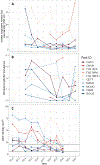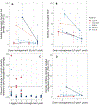Deer management generally reduces densities of nymphal Ixodes scapularis, but not prevalence of infection with Borrelia burgdorferi sensu stricto
- PMID: 37244157
- PMCID: PMC11265508
- DOI: 10.1016/j.ttbdis.2023.102202
Deer management generally reduces densities of nymphal Ixodes scapularis, but not prevalence of infection with Borrelia burgdorferi sensu stricto
Abstract
Human Lyme disease-primarily caused by the bacterium Borrelia burgdorferi sensu stricto (s.s.) in North America-is the most common vector-borne disease in the United States. Research on risk mitigation strategies during the last three decades has emphasized methods to reduce densities of the primary vector in eastern North America, the blacklegged tick (Ixodes scapularis). Controlling white-tailed deer populations has been considered a potential method for reducing tick densities, as white-tailed deer are important hosts for blacklegged tick reproduction. However, the feasibility and efficacy of white-tailed deer management to impact acarological risk of encountering infected ticks (namely, density of host-seeking infected nymphs; DIN) is unclear. We investigated the effect of white-tailed deer density and management on the density of host-seeking nymphs and B. burgdorferi s.s. infection prevalence using surveillance data from eight national parks and park regions in the eastern United States from 2014-2022. We found that deer density was significantly positively correlated with the density of nymphs (nymph density increased by 49% with a 1 standard deviation increase in deer density) but was not strongly correlated with the prevalence of B. burgdorferi s.s. infection in nymphal ticks. Further, while white-tailed deer reduction efforts were followed by a decrease in the density of I. scapularis nymphs in parks, deer removal had variable effects on B. burgdorferi s.s. infection prevalence, with some parks experiencing slight declines and others slight increases in prevalence. Our findings suggest that managing white-tailed deer densities alone may not be effective in reducing DIN in all situations but may be a useful tool when implemented in integrated management regimes.
Keywords: Borrelia burgdorferi sensu stricto; Ixodes scapularis; Lyme disease; blacklegged tick; density of infected nymphs; white-tailed deer density.
Copyright © 2023. Published by Elsevier GmbH.
Conflict of interest statement
Declaration of Competing Interest The authors declare no conflicts of interest.
Figures





References
-
- Brilleman S, Crowther M, Moreno-Betancur M, Buros Novik J, Wolfe R, 2018. Joint Longitudinal and Time-To-Event Models Via Stan. StanCon Pacific Grove, CA, USA. - PubMed
MeSH terms
Supplementary concepts
Grants and funding
LinkOut - more resources
Full Text Sources
Medical

